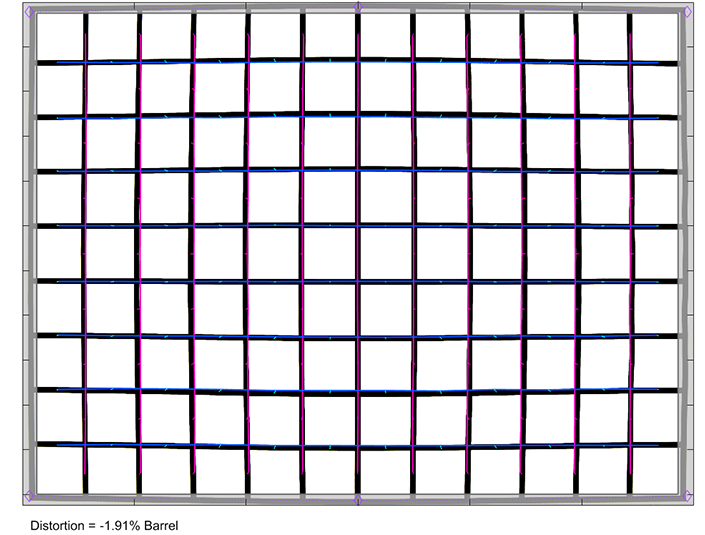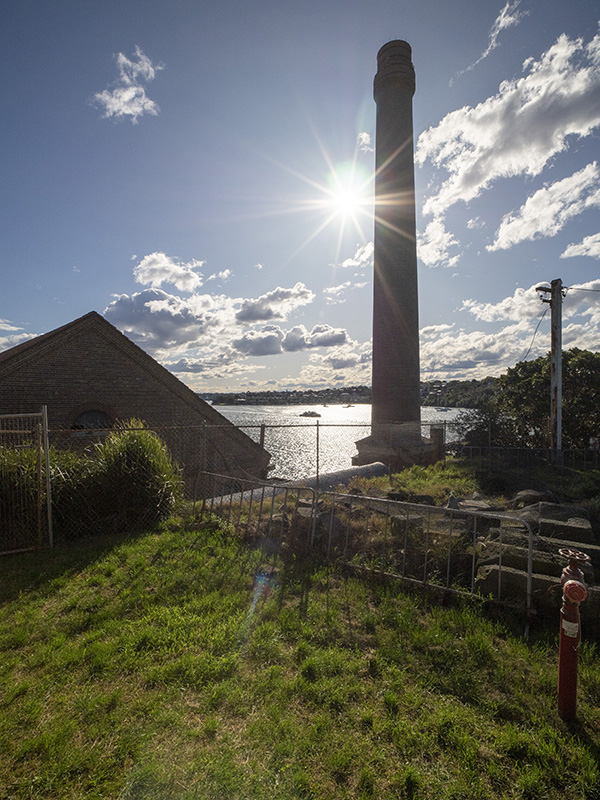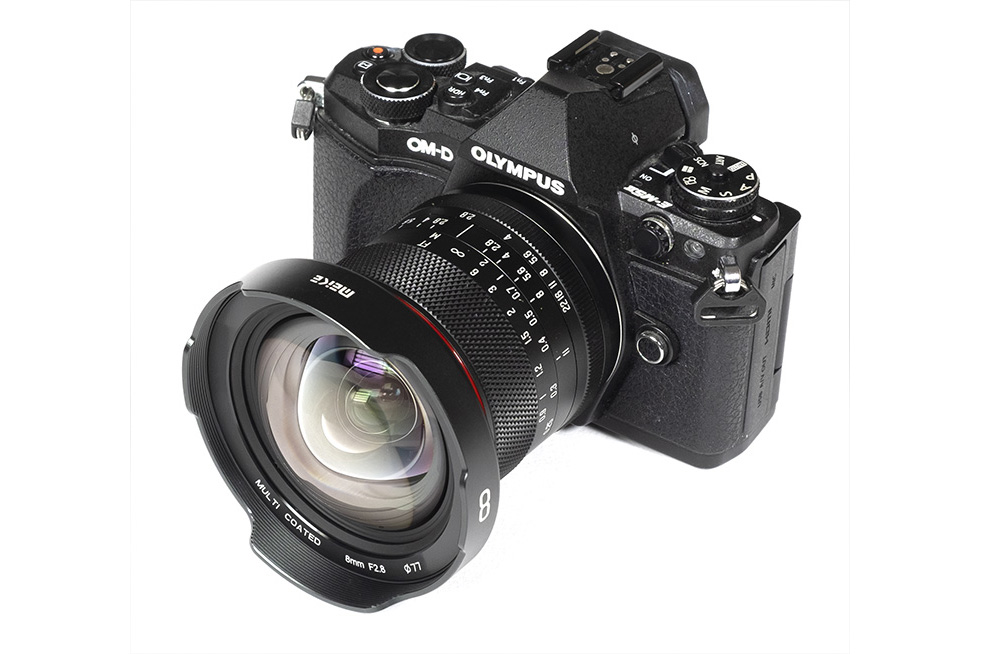Review by Klaus Schroiff, published August 2022
Table of Contents
Introduction
Meike has had quite a stampede of new lens releases lately. One of their most ambitious new designs is the new Meike 8mm f/2.8 MFT. You may think that this is another fish-eye, but it is, in fact, a fully correct ultra-wide lens equivalent to 16mm on full-format cameras.
Priced at $399 USD, it is not a budget item anymore, but it’s also not your average optical construction either – consisting of no less than 17 elements, including two aspherical elements.
So it seems that Meike wants to move up the food chain now.
Meike’s latest lenses moved towards a more uniform and recognizable look, and it’s quite an attractive one in our book. The signature elements of this design are a knurled focus ring and a red ring near the lens front.
The body is an all-metal construction, including the built-in petal-shaped lens hood. The focus ring and the clickless aperture ring operate smoothly and are dampened. You may notice the bulb-like front element and may come to the conclusion that filters can’t be attached. However, the lens hood can actually accept 77mm filters.
While the lens itself has an excellent build quality, the front lens cap is made of soft plastic, which is prone to scratches.

Like most of the lenses in Meike’s lineup, the 8mm f/2.8 is a fully-manual lens without any electronic coupling. Given its ultra-wide nature, manual focusing is usually easy. However, the lack of EXIF data also means you’ll have to manually tune the camera’s image stabilizer to 8mm.
| Specifications | |
|---|---|
| Equiv. focal length (full-format) | “16mm” (in terms of field-of-view) |
| Equiv. aperture (full-format) | “f/5.6” (in terms of depth-of-field) |
| Optical construction | 17 elements in 12 groups inc. 2x aspherical elements |
| Number of aperture blades | 5 |
| min. focus distance | 0.25m (max. magnification 1:?) |
| Dimensions | ?mm |
| Weight | 480g |
| Filter size | φ77mm |
| Hood | petal-shaped, built-in |
| Other features | – |
| Mount | Micro-Four-Thirds |
Distortion
As mentioned, the Meike 8mm f/2.8 doesn’t feature electronic coupling thus there’s also no image auto-correction available. However, the Meike lens does a good job when it comes to its native distortion characteristic anyway. It produces a medium barrel distortion of ~1.9%. While this is noticeable in certain scenes, it’s not overly disturbing either.

Vignetting
The vignetting is reasonably well corrected, although some of this also relates to the “natural” vignetting that is associated with all ultra-wide lenses.
At f/2.8, the light falloff is clearly visible at 1.4EV (f-stops). Even so, this is far less compared to typical MFT lenses, which fully rely on auto-correction.
Stopping down gradually reduces the light falloff. Usually, you should not stop down beyond f/5.6 on MTF cameras and the vignetting stays at just under 1EV (f-stop) here.
Not brilliant but not terrible either, considering the focal length.

MTF (resolution)
The primary strength of the Meike lens – and probably also the biggest surprise – is its resolution characteristic. It is sharp. At all settings. And across the image field.
In fact, it is one of the sharpest ultra-wide MFT lenses that we’ve reviewed so far.
Despite the impressive MTF figures, it’s worth noting that there’s a bit of field curvature present at f/2.8, so it’s still best to stop down to f/4.
The centering quality of the tested sample was good.
Please note that the MTF results are not directly comparable across the different systems!
Below is a simplified summary of the formal findings. The chart shows line widths per picture height (LW/PH) which can be taken as a measure of sharpness. If you want to know more about the MTF50 figures, you may check out the corresponding Imatest Explanations.

Chromatic Aberrations (CAs)
Lateral CAs (color shadows at the image borders) are very moderate, with an average pixel width of around ~0.4px across all relevant aperture settings.

Flare and Sunstars
Below is a rather extreme shot into the sun taken at f/5.6 – and some heavy post-processing to recover the shadows. There are a couple of observations here.
The lens can produce nice sun stars – and they are best at f/5.6. We’ve taken a couple of images of this scene, and the sun stars deteriorate at other aperture settings.
However, f/5.6 is basically the ideal setting for this lens, so that’s perfectly fine.
You may also spot some ghosting, but this is hardly surprising, given the extreme setup here. Generally, we’d say that the lens isn’t overly prone to flare effects.
However, you may spot some veiling glare around extreme contrasts in some of our sample images shown on the next page.

Competition
There are two primary competitors for the Meike 8mm f/2.8 at this stage – the Panasonic Leica DG 9mm f/1.7 ASPH and the Laowa 7.5mm f/2. Obviously, the Meike 8mm f/2.8 loses in terms of speed in both cases. The Panasonic lens also offers auto-focusing, and the Laowa can be purchased with aperture coupling at least.
However, the Meike 8mmm f/2.8 is optically superior to the Laowa 7.5mm f/2. We can’t comment on the Panasonic lens – yet – but it has received rather mixed reviews in terms of its optical qualities. Price-wise, the Meike lens is more affordable at $399 vs $549 (Laowa) and $599 (Panasonic), respectively.
Sample Images
The Meike 8mm f/2.8 MFT is a pleasant surprise in the MFT arena. Its primary strength is sharpness across the image field and all relevant aperture settings.
Field curvature is a slight issue at f/2.8, so it's still best to stop down to f/4 for optimal results. This will also reduce the vignetting, which is very noticeable at a fully-open aperture.
Image distortion can be visible, but they are still fairly moderate for such an extreme ultra-wide lens. If you are into sun stars, the lens can do that for you.
They are pretty pleasing around the f/5.6 mark, less so at other settings. The lens is comparatively resistant against flare, but you may spot veiling glare at harsh contrast transitions.
The build quality of the Meike lens is excellent. It's a tightly assembled, full-metal construction.
Compared to e.g. some of the Loawa lenses, the Meike 8mm f/2.8 MFT is fairly big, but the complex optical design has to fit in somewhere. The control rings are super-smooth.
Whether you like the clickless aperture ring or not is a matter of taste - videographers will surely prefer it, but we were perfectly fine with it during our field sessions as well.
If anything, we'd say that the plastic front cap could be improved. That's besides the fully manual nature of the lens.
There is no electronic coupling thus, you'll have to live with manual focusing, manual aperture and without EXIF data. Given the ultra-wide focal length, we wouldn't call this a showstopper.
The Meike 8mm f/2.8 MFT is fairly priced at $399USD. So if you are in the market for a new ultra-wide prime lens, it's worth putting the Meike lens on your radar.
-
Optical Quality
-
Build Quality
-
Price/Performance


